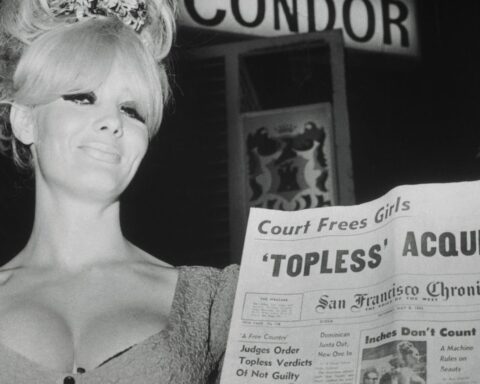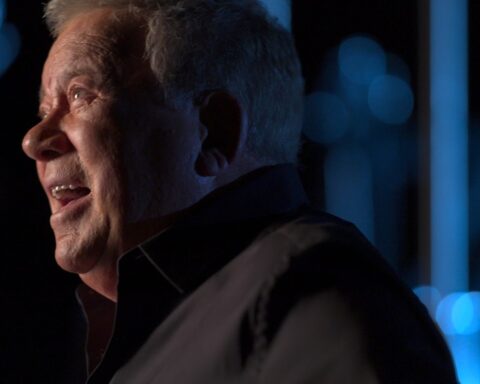The Great Buster: A Celebration
(USA, 104 min.)
Dir. Peter Bogdanovich
“What you see is what you get,” says film critic Leonard Maltin while appraising the works of Buster Keaton in The Great Buster. “To me, the best special effect in his films is Buster.”
Maltin is one of many notable figures in the film world who gushes about the appropriately monikered Buster Keaton in The Great Buster: A Celebration. Peter Bogdanovich’s documentary truly is a celebration of one of the silent film era’s greatest and most influential stars. Keaton’s shot at being #1 on the list is rivalled only by Charlie Chaplin, but Bogdanovich and company aren’t interested in comparing the stars to see who comes out on top. What you see is what you get with The Great Buster and this fun and informative slice of film history is an unabashed celebration of cinephilia.
The film charts a cradle to grave portrait of Keaton’s career beginning with his Vaudeville days when he was the main attraction in the family act. Little Buster’s knack for physical comedy upstaged his parents and paved the way for childhood stardom. Bogdanovich, using some novel archival photos, observes that Keaton had his own car at the age of 12 and a signature trademark in his stone face that would help make him a comedic icon. Following the demise of the Keaton family show—which, as Buster’s siblings reveal in an archival interview, happened following his insistence that the younger Keatons not miss an education like he did—Hollywood beckoned and Keaton used his Vaudeville chops to make America laugh harder than it ever had before.
The Great Buster offers a highlight reel of the best and worst of Keaton’s filmography. It’s surprising how well some of the short reels hold up despite being nearly 100 years old. (On the other hand, some are awfully dated.) Keaton’s sense of comedic timing, his deadpan expressions, and his innovative use of technology and film form are timeless ingredients for great comedy. As Bogdanovich and the chorus of talking heads unpack their favourite gags and moments in the Keaton oeuvre, the doc credits Buster for pioneering stunt work and practical effects to advance the cinematic art form. Some of Keaton’s stunts are astonishing feats that continue to inspire comedians, like the sight gag from Steamboat Bill, Jr. in which the front wall of a house fell and narrowly avoided crushing the comic by carefully placing him within a window frame. Quentin Tarantino (Pulp Fiction) makes a case that, in addition to being a great comedic director, Keaton was a technological innovator and a master of action films thanks to his sense of timing and scale. This clip from Steamboat is just one great example, while sweeping snippets from The General offer strong evidence to support the claim.
As the title for the film indicates, The Great Buster: A Celebration draws from the praises of Keaton fans in the film world. The doc treads hagiography as the chorus of stars, including Carl Reiner, Bill Hader, Cybill Shepherd, Mel Brooks, and Dick Van Dyke gush about Keaton’s greatness and his influence on their careers. Bogdanovich also draws some utterly random interviewees, particularly director Werner Herzog, who adds little to the conversation beyond novelty and star power. Some unexpected voices, like Jackass trickster Jonny Knoxville and Spider-Man director John Watts offer unique perspectives on Keaton’s influence on a range of contemporary work from the shock-filled stunts of Jackass to the webbed-avenger’s stoic face.
The interviews complement the archival images, which, while extensive, offer little footage of Keaton the man. There is a lot of footage of Keaton the performer, but the film finds some images of Keaton unmasked in clips from the 1965 NFB documentary Buster Keaton Rides Again that Bogdanovich provides. The NFB doc, a behind-the-scenes verité film about the making of the slapstick short The Railrodder — perhaps Keaton’s last great hurrah with silent film style—is a highlight of the film as it shows Keaton discuss the creative process with his collaborators and provide some insight on his approach to film comedy. One wishes Bogdanovich could offer more looks at Keaton’s life beyond his filmography and one might attribute the scarcity of candid footage to the cost of home moviemaking in the early years of cinema. The doc features some commentary on Keaton’s alcoholism, depression, and failed marriages to add some balance to its portrait.
Bogdanovich might be a better film historian than he is a director, and this comment is by no means a slight on his filmmaking, and fans of classic cinema while love his well-researched and articulate dive into the silent era. He looks back at Keaton’s prolific output in the last decade of the sound era as a Golden Age of Hollywood. The introduction of Keaton’s depression and alcoholism coincides with his transition to sound-era studio filmmaking, which Bogdanovich interprets with a balanced mix of criticism both negative and positive. Bogdanovich’s textual and contextual analysis of the films sees a decline in Keaton’s work and spirit as he surrendered aspects of creative control to the system and saw the films decline in the hands of lesser talents.
However, Bogdanovich finds in Keaton an effective metaphor for the creative individual within the Hollywood studio system. He looks back to a pivotal and prolific period in Keaton’s silent filmography from 1923 to 1926. Bogdanovich offers an in-depth case study of this period in which Keaton directed and starred in ten feature films including Steamboat Bill, Jr. and his most acclaimed work, The General. As Bogdanovich pores over the images of these Keaton films and interprets the best work by the artist as both an actor and a filmmaker, he observes the greatness that the cinema can achieve when independent artists have the resources and canvases to be innovative and original.
Bogdanovich’s study of Keaton resonates as the studios find themselves in a new era of flux with streaming and digital disrupting the industry just as sound, and then television, changed the way people make and consume movies. Whether the art form flourishes or flounders is up to the people calling the shots, but if the studios want to succeed with great art that endures, they’ll be smart to look closely at the chapter of Keaton’s filmography that Bogdanovich so wisely identifies as his greatest.
The Great Buster: A Celebration opens at Hot Docs Ted Rogers Cinema on Dec. 21.











